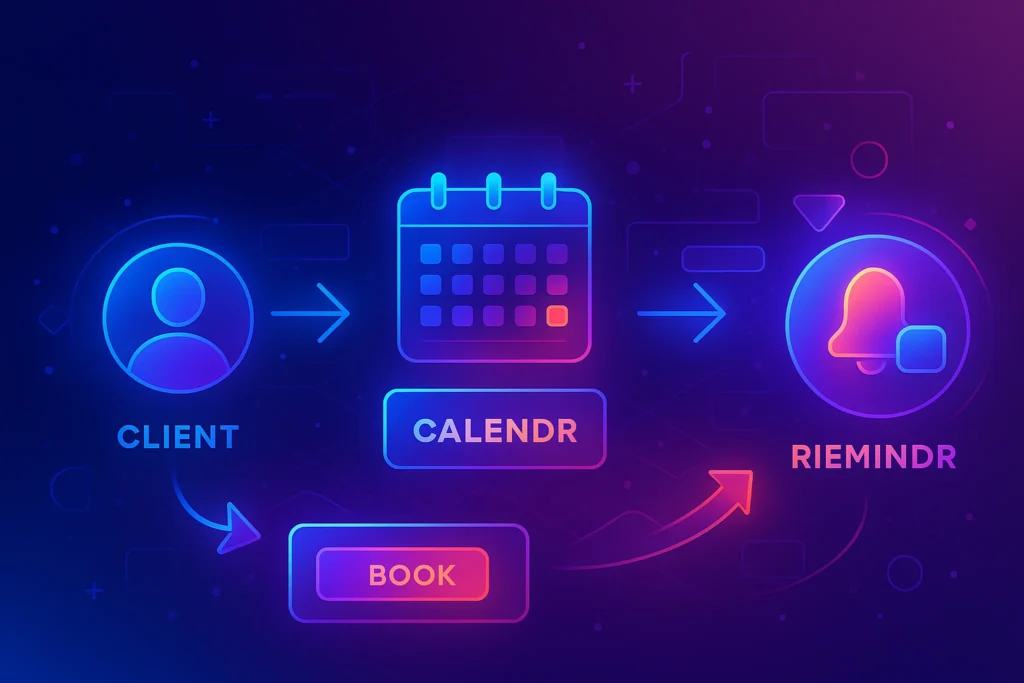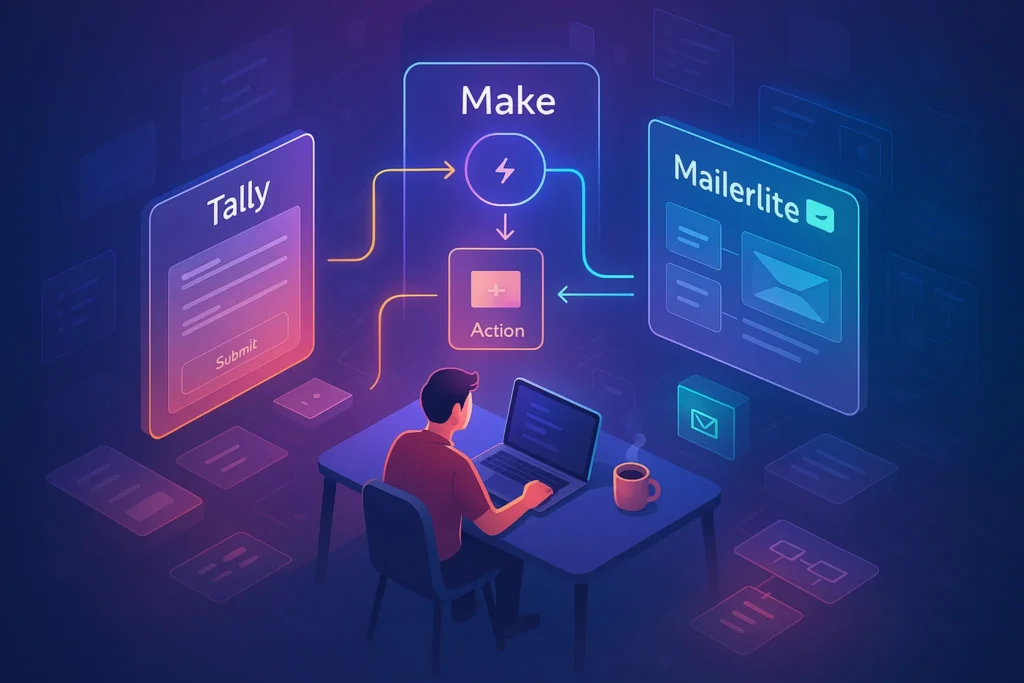🚀 Why Manual Scheduling Is Costing You Time
If you’ve ever spent half a day trading emails just to set up a single meeting, you know how frustrating manual scheduling can be. Back-and-forth messages, calendar conflicts, no-shows, and forgotten reminders all eat into productive hours. For freelancers, consultants, or businesses managing multiple clients, this wasted time directly impacts revenue.
That’s where automated appointment booking systems come in. Instead of manually checking availability, clients can view your real-time calendar, book a slot that works, and get automatic confirmations and reminders. Payments, intake forms, and even follow-ups can all be baked into the process.
By the end of this guide, you’ll know exactly how to set up a streamlined, professional booking workflow—whether you’re a solo coach, a digital agency, or a service-based business.
🛠️ Step 1: Choose the Right Appointment Tool
The first and most important step is selecting the scheduling platform that fits your business model. While all booking tools share the same core idea—let clients pick a time from your calendar—the way they approach integrations, branding, and customization is very different. For instance, Calendly is excellent for professionals who need a quick, clean solution that integrates with tools like Zoom and Google Workspace. On the other hand, Acuity Scheduling gives you more control over intake forms and payments, which makes it ideal for consultants, therapists, and fitness coaches. If budget is your main concern, TidyCal offers a one-time lifetime purchase that’s hard to beat. Larger businesses already invested in a software ecosystem might prefer Zoho Bookings since it ties directly into their CRM, while Google Calendar add-ons are good enough for freelancers who just need something simple and free.
When deciding, don’t just look at the price—think about your workflow. Do you need group sessions? Do you want to charge for consultations upfront? Will this integrate with your CRM or email marketing system? The right choice early on prevents painful migrations later.
The foundation of your system is the scheduling tool itself. The best platforms are designed to eliminate friction while offering integrations that match your workflow.
Popular options include:
-
Calendly: The market leader, known for simplicity, calendar sync, and powerful integrations.
-
Acuity Scheduling: Ideal for coaches and consultants who need forms, intake questions, and payment collection.
-
TidyCal: Budget-friendly option with lifetime deals, perfect for solopreneurs.
-
Zoho Bookings: Strong choice for businesses already in the Zoho ecosystem.
-
Google Calendar Add-ons: Basic, but free for Google Workspace users with modest needs.
When choosing, think beyond price. Ask: Does it integrate with my CRM? Can it handle team scheduling? Does it support payment gateways?
For deeper context, our guide on How to Automate Client Onboarding Without Coding explores how tools like Acuity and Calendly connect seamlessly with intake and onboarding flows.
🛠️ Step 2: Sync with Your Calendars
Once your booking tool is selected, syncing it with your existing calendars is essential. The whole point of automation is to avoid clashes, so real-time synchronization ensures you never risk double-booking. Imagine a client schedules a consultation at 2 PM, but you already had a doctor’s appointment blocked on your personal calendar. Without sync, the system would show you as “available,” creating unnecessary frustration.
Most modern booking tools connect instantly with Google Calendar, Outlook, or iCal, pulling your availability in real-time. This means clients always see your true free slots, not just your working hours. For team setups, the tool can even distribute bookings intelligently across multiple staff members. Syncing isn’t just about preventing mistakes—it builds trust. Clients see that your availability is always current, and you avoid awkward reschedules that can damage professionalism.
Once you’ve picked your platform, the next step is syncing it with your existing calendars. Most tools integrate with Google Calendar, Outlook, and iCal, ensuring your availability is always up-to-date.
Here’s how it works in practice:
-
You connect your main calendar to the tool.
-
The platform checks for conflicts (existing meetings, blocked times, holidays).
-
Available slots are automatically displayed to clients.
-
Any new booking instantly appears on your personal calendar.
This is crucial because double-bookings are one of the top pain points clients complain about. With real-time sync, the system ensures you’re never caught in a scheduling mess.
🛠️ Step 3: Automate Confirmations and Reminders
Even after someone books, the process doesn’t end. A surprising number of meetings fall through simply because people forget. Automated confirmations and reminders make sure both you and your client are aligned. The system should instantly send a confirmation email summarizing the details—time, date, and method of meeting (Zoom link, phone, in-person). Then, reminders go out automatically, often 24 hours before and sometimes again an hour before.
The best tools allow you to customize the language of these reminders so they reflect your brand’s tone. Some also support SMS reminders, which are incredibly effective for busy clients who may not check email often. Beyond reducing no-shows, reminders show professionalism: your clients feel cared for, and you spend less energy chasing people down. In fact, businesses that implement automated reminders report a 30–40% drop in missed appointments, which directly translates into saved time and revenue.
Booking a time is just the beginning. The real magic of automation is in reminders and confirmations, which dramatically reduce no-shows.
A well-designed system will:
-
Send an instant confirmation email when the booking is made.
-
Trigger a reminder 24 hours before the meeting.
-
Optionally, send a text (SMS) an hour before.
-
Include cancellation/rescheduling links to reduce friction.
This kind of setup isn’t just professional—it saves you from manually reminding clients. According to service businesses, automated reminders can reduce no-shows by as much as 40%.
We’ve covered similar time-saving strategies in our article on Automating Invoice Creation and Payment Reminders, where small process tweaks free up hours weekly.
🛠️ Step 4: Collect Information During Booking
Not all appointments are equal, and the last thing you want is to spend the first 15 minutes of every call asking basic questions. By embedding intake forms into the booking process, you can collect the information you need upfront. For example, a marketing consultant might ask about a client’s current advertising budget, while a fitness coach could collect health background or training goals.
Well-designed booking forms not only save time but also improve the quality of your sessions. You arrive prepared, your client feels valued because you’ve already considered their needs, and the overall professionalism of your brand increases. Most tools let you create custom fields—checkboxes, short answers, or dropdowns—so you can adapt the booking process to your exact workflow. Think of it as pre-qualifying your clients: the data helps you deliver better service and ensures you’re spending time with the right people.
Not all appointments are the same. Sometimes you need context before the call: What’s the client’s budget? What service are they interested in?
Most scheduling platforms let you embed forms directly into the booking flow. For example:
-
A therapist might ask new clients to complete an intake form.
-
A digital marketer might ask about business goals and ad spend.
-
A fitness coach could ask about health history.
This saves valuable meeting time and allows you to prepare in advance. Acuity, Calendly, and Zoho all offer customizable form options.
🛠️ Step 5: Integrate Payments (Optional but Powerful)
For many service businesses, the ability to collect payments upfront is the difference between consistent cash flow and unpredictable revenue. Integrating payments into your booking system eliminates the need for separate invoices, reduces cancellations, and locks in client commitment. Platforms like Stripe, PayPal, or Square can be connected to most modern booking tools, allowing clients to pay as they schedule.
This is particularly useful for consultants, coaches, and healthcare professionals who run fee-based sessions. Instead of spending energy chasing late payments, you know every session is confirmed and paid for before it happens. Clients also benefit because they get instant receipts and peace of mind. Even if you don’t want to charge for every session, offering optional prepayment for premium services or extended packages can help stabilize your income. Payment integration turns your booking system from a passive scheduler into a full-fledged revenue engine.
For service providers, paid consultations or classes are common. Instead of invoicing manually, you can integrate Stripe, PayPal, or Square directly into the booking system.
Benefits of payment integration:
-
Ensures commitment (reduces cancellations).
-
Streamlines financial tracking.
-
Offers instant receipts for clients.
For example, a consultant could charge $150 for a 60-minute strategy session. The client books, pays upfront, and receives both a receipt and appointment confirmation—without you lifting a finger.
If you’re exploring full-service automation, our comparison of Zapier Alternatives for Budget-Friendly Workflow Automation shows how to connect booking + payment with CRM, accounting, and follow-up tools.
📊 Comparison Table: Appointment Booking Tools in 2025
| Tool | Pricing | Integrations | Best For |
|---|---|---|---|
| Calendly | Free / $12–$16/mo | Google, Zoom, Stripe, HubSpot | General use, professional teams |
| Acuity | $20–$35/mo | Zapier, Stripe, PayPal, CRM tools | Coaches, consultants, paid sessions |
| TidyCal | Lifetime $29–$59 | Google, Outlook, Zapier | Solopreneurs, budget-conscious |
| Zoho Bookings | Free / $8–$12/mo | Zoho apps, Office 365, Stripe | Businesses in Zoho ecosystem |
| Google Calendar Add-ons | Free with Workspace | Gmail, Meet, limited third-party | Basic scheduling needs |
🎨 Checklist: 5 Must-Have Features in an Automated Booking System
-
✅ Calendar Sync to prevent double-bookings.
-
✅ Automated Reminders (email/SMS).
-
✅ Customizable Booking Forms for client info.
-
✅ Payment Integration for paid sessions.
-
✅ Third-Party Integrations (Zoom, CRMs, email tools).
If your chosen tool doesn’t cover all five, you’ll end up compensating manually—which defeats the purpose of automation.
🖇️ Workflow Example: How It All Comes Together
Imagine this simple flow:
User → Booking Page → Calendar Sync → Confirmation + Reminders → Meeting
-
A client clicks your booking link.
-
They see your availability in real-time.
-
They choose a slot, fill out intake details, and pay (if required).
-
The system syncs to your calendar.
-
The client automatically gets reminders leading up to the meeting.
This end-to-end automation means you never send a scheduling email again.
✅ Pros and ❌ Cons of Automated Booking Systems
Pros:
-
✅ Saves hours of back-and-forth scheduling.
-
✅ Reduces no-shows through reminders.
-
✅ Collects client data upfront.
-
✅ Seamlessly integrates payments.
-
✅ Improves professionalism and client trust.
Cons:
-
❌ Some tools can be expensive for premium features.
-
❌ Setup requires time investment (forms, integrations).
-
❌ Not all clients are comfortable booking online (though this is shrinking fast).
📬 Want Smarter Automation Tips?
Join the NerdChips newsletter and get weekly insights on automation tools, no-code workflows, and productivity systems—delivered straight to your inbox.
No fluff. Just actionable strategies for creators, consultants, and digital-first businesses.
🔐 100% privacy. No spam. Unsubscribe anytime. Just value-packed automation tips from NerdChips.
🔍 Mini Case Studies: How Real People Use Automated Booking
Freelancer Example:
Amir, a freelance IT consultant, used to lose hours each week emailing clients to find meeting times. After switching to TidyCal, he sent one booking link, synced it with his Google Calendar, and let clients self-book. The result? 8 extra billable hours per week.
Fitness Coach Example:
Maria, a personal trainer, integrated Acuity Scheduling with Stripe. Clients now pay at booking, fill out health intake forms, and get automatic reminders. Her no-shows dropped by 60%, and cash flow improved instantly.
Agency Example:
A small digital marketing agency adopted Calendly for team scheduling. Each team member’s calendar is linked, so leads automatically book with the right person. This streamlined client acquisition and doubled discovery calls in just 3 months.
📈 The ROI of Automated Booking Systems
An automated booking flow isn’t just about saving time—it’s about making more money.
-
Reduced no-shows: Automated SMS and email reminders cut no-shows by 30–40%. That’s revenue you no longer lose.
-
Higher client volume: By removing the friction of scheduling, clients book faster and more often.
-
Time savings → more revenue: If automation frees even 5 hours per week, that’s 20 hours per month. For a consultant charging $100/hr, that’s $2,000 worth of reclaimed time.
Put simply: what feels like a small productivity upgrade can directly add thousands to annual revenue.
🧩 Where Appointment Booking Fits in Your Automation Stack
An appointment system is rarely used alone—it’s part of a bigger automation picture:
-
CRM Integration: Leads who book are instantly added to your CRM (HubSpot, Zoho, Salesforce).
-
Payments: Booking fees flow directly to Stripe or PayPal, syncing with your accounting system.
-
Video Conferencing: Zoom or Google Meet links are auto-generated and sent to both parties.
-
Marketing Automation: Post-meeting follow-ups trigger automated email sequences.
For businesses already exploring workflow automation, tools like Calendly and Acuity sit right next to Zapier Alternatives for Budget-Friendly Workflow Automation, ensuring every client touchpoint is tracked and optimized.
⚠️ Common Mistakes to Avoid
-
Relying only on free plans. Many free tiers are good for tests but lack reminders or payments. Businesses quickly outgrow them.
-
Not testing reminders. If confirmation emails go to spam or SMS fails, no-shows won’t improve. Always test.
-
Overcomplicating booking forms. Long forms discourage clients. Only ask for the essentials upfront.
-
Forgetting mobile users. If your booking page isn’t mobile-friendly, you lose half your potential bookings.
-
No payment collection. For paid services, not requiring payment upfront leads to cancellations and lost revenue.
Avoiding these mistakes ensures your system truly saves time instead of creating new problems.
📊 Industry Use Cases
Healthcare & Clinics: Patients self-book appointments, reducing calls to the front desk. HIPAA-compliant platforms also allow intake forms securely.
Legal & Consulting: Lawyers can collect case details during booking and charge consultation fees upfront.
Education & Coaching: Tutors and coaches automate recurring sessions and group class scheduling.
Agencies & Creative Studios: Teams share a booking page, and prospects auto-match with available staff, improving lead handling.
Wellness & Fitness: Trainers and therapists use reminders to reduce missed sessions and integrate payments for classes or packages.
✅ Transition Back
Now that we’ve seen real examples, ROI benefits, ecosystem placement, and common mistakes, it’s clear automated appointment systems aren’t just convenience tools—they’re revenue multipliers. Next, let’s break down the pros and cons so you can decide if it’s right for your workflow.
🧠 Nerd Verdict
Building an automated booking system in 2025 isn’t just about convenience—it’s about professionalism and scalability. For freelancers and agencies, it’s the difference between losing hours to scheduling chaos or letting a system handle it while you focus on delivering value.
The best part: once set up, these systems run quietly in the background, cutting friction for both you and your clients.
❓ FAQ: Automated Appointment Booking
💬 Would You Bite?
Would you trust an automated booking system to handle all your appointments, or do you still prefer manual control?
👇 Share your perspective in the comments!



